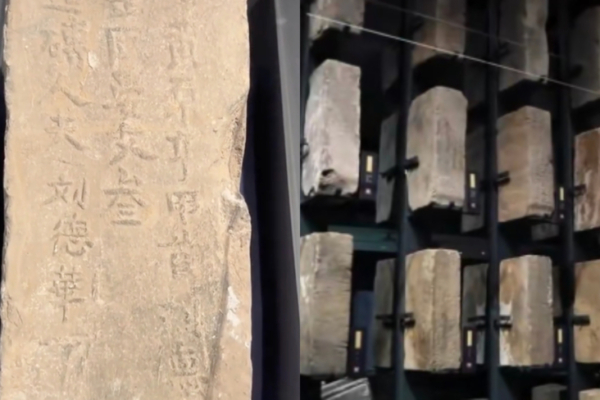650 years ago, during the Ming Dynasty, a man named “Liu Dehua” was responsible for making the bricks used to construct the Yingtian City for Emperor Zhu Yuanzhang, the founding emperor of the Ming Dynasty. Each brick he made had his name engraved on it, and if any quality issue arose with the bricks, he would be held accountable.
A viral video on the internet shows that the Nanjing City Wall Museum displays many ancient bricks from the Ming Dynasty, with one brick bearing the inscription “Liu Dehua.” This ancient craftsman shares the same name as the Hong Kong actor, Andy Lau, which has caught the attention of netizens.
According to reports by Shaanxi TV News, when Emperor Zhu Yuanzhang, the Ming Taizu, established his capital in Yingtian (the ancient name for Nanjing) and built the Yingtian City, he mobilized millions of soldiers and civilians from Jiangnan at the time to help in making the city wall bricks. To ensure quality, each brick was inscribed with text so that if any issues arose, the responsible individuals could be traced.
The inscription on the side of the “Liu Dehua” brick reads: “The Magistrate of Ruizhou Prefecture and the County Judge of Shanggao County, Cheng Yisi and the Clerk Ai Cheng, and the Magistrate of Shanggao County and the County Magistrate Lü Yi and the Clerk Zhao Yongbin.”
On the other side of the inscription, it reads: “The Supervisor Huang Yuanheng, the Bricks Supervisor Liu Dehua, the Assistant Supervisor Jian Wenhua, the Kiln Worker Yan Wensan, and the Brick Maker Liu Dehua.”
From the inscriptions, it is known that “Liu Dehua” was from Shanggao County in the early Ming Dynasty (now Gao’an City, Jiangxi), serving both as a “Bricks Supervisor” and a participant in the brick-making process.
The “Bricks Supervisor” was a grassroots manager in the Ming brick-making operations, while the “Brick Maker” was an ordinary citizen directly involved in the brick-making process.
In other words, this “Liu Dehua” from the Ming Dynasty not only managed at the grassroots level but also personally participated in brick-making. Currently, six bricks made by him have been found.
So why did the Ming Dynasty hundreds of years ago use simplified Chinese characters for “刘” (Liu) rather than traditional Chinese characters “劉” (Liu)?
According to research, “刘” had been in common use alongside “劉” as early as the Jin Dynasty, representing a variant form or what is now known as an “alternative character.” “刘” was also the customary writing style for Ming craftsmen, with many Ming Dynasty artifacts such as porcelain featuring the simplified character “刘.”
In some popular novels of the Yuan, Ming, and Qing dynasties, such as “Gu Jin Za Ju” (Ancient and Modern Plays), “San Guo Zhi Ping Hua” (The Romance of the Three Kingdoms Simplified), “Tai Ping Le Fu” (Songs of the Taiping Era), “Mu Lian Ji” (Records of Mulian), and “Ling Nan Yi Shi” (Anecdotes of Lingnan), “劉” (Liu) was also written as “刘” (Liu).
Even over six hundred years ago during the Ming Dynasty, a system of lifelong accountability for construction quality was implemented when building city walls. Based on the inscriptions on the bricks, there were 11 levels of official positions, so if an issue arose with a brick, whether it was an official or a commoner, they would all be equally held accountable.
Many netizens pondered: “With such a rigorous quality control system, it’s no wonder the grand buildings of the Great Ming Dynasty are magnificent and spectacular.”

